SpaceX Falcon Heavy Sticks Triple Rocket Landing with 1st Commercial Launch
Falcon Heavy is officially in business.
CAPE CANAVERAL, Fla. — SpaceX's Falcon Heavy successfully launched its first operational mission today (April 11), sticking a triple-rocket landing more than a year after its demo mission catapulted a cherry-red Tesla and a dummy nicknamed Starman into space.
The megarocket, dubbed the most powerful launcher in operation, blasted off at 6:35 p.m. EDT (2235 GMT). It lifted off here from the same site that once hosted NASA's Apollo moon missions and its fleet of space shuttles: historic Pad 39A at NASA's Kennedy Space Center. About 34 minutes later, the rocket deployed Arabsat-6A, an advanced communications satellite that will provide internet and communications services to residents of the Middle East, Africa and parts of Europe.
Falcon Heavy's second flight went off without a hitch at the beginning of a 2-hour window after high upper level winds thwarted SpaceX's second launch attempt. A day earlier, Falcon Heavy faced a 24-hour delay due to poor weather at the launch pad. A dismal weather forecast for Tuesday (April 9) convinced launch officials to issue a delay rather than face just a 30% chance of favorable weather.
Related: In Photos: SpaceX's 1st Falcon Heavy Rocket Test Launch Success!
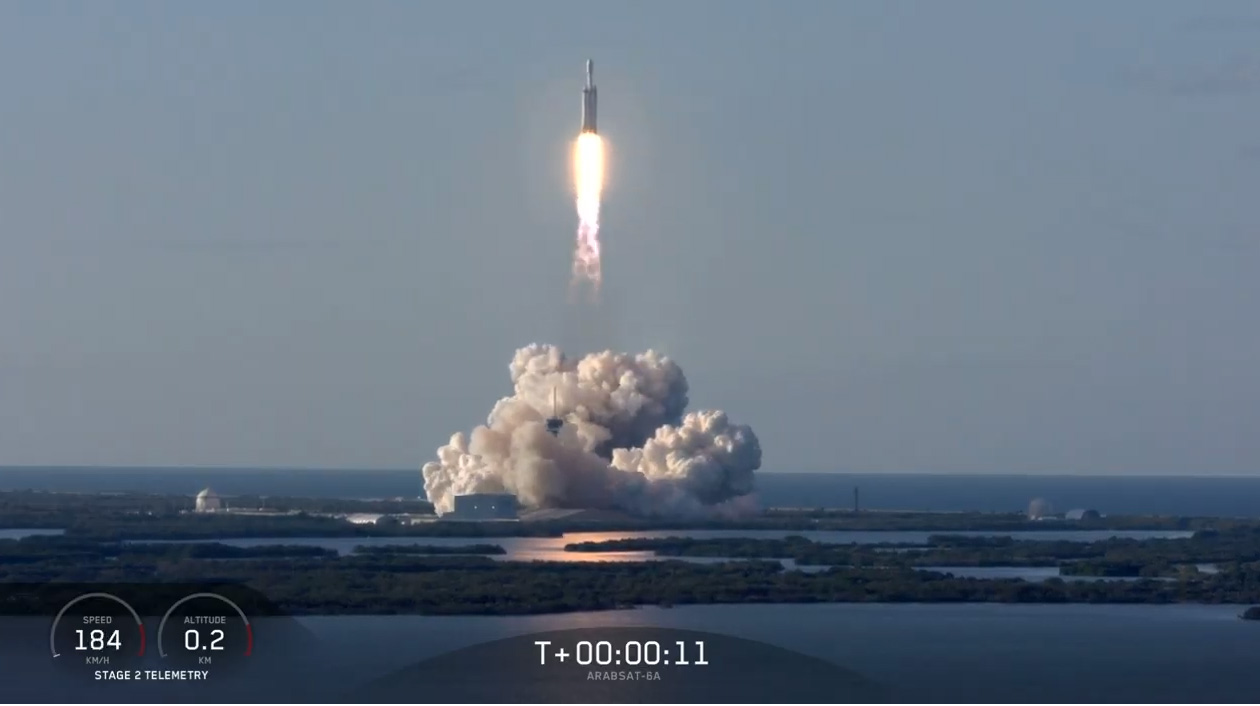
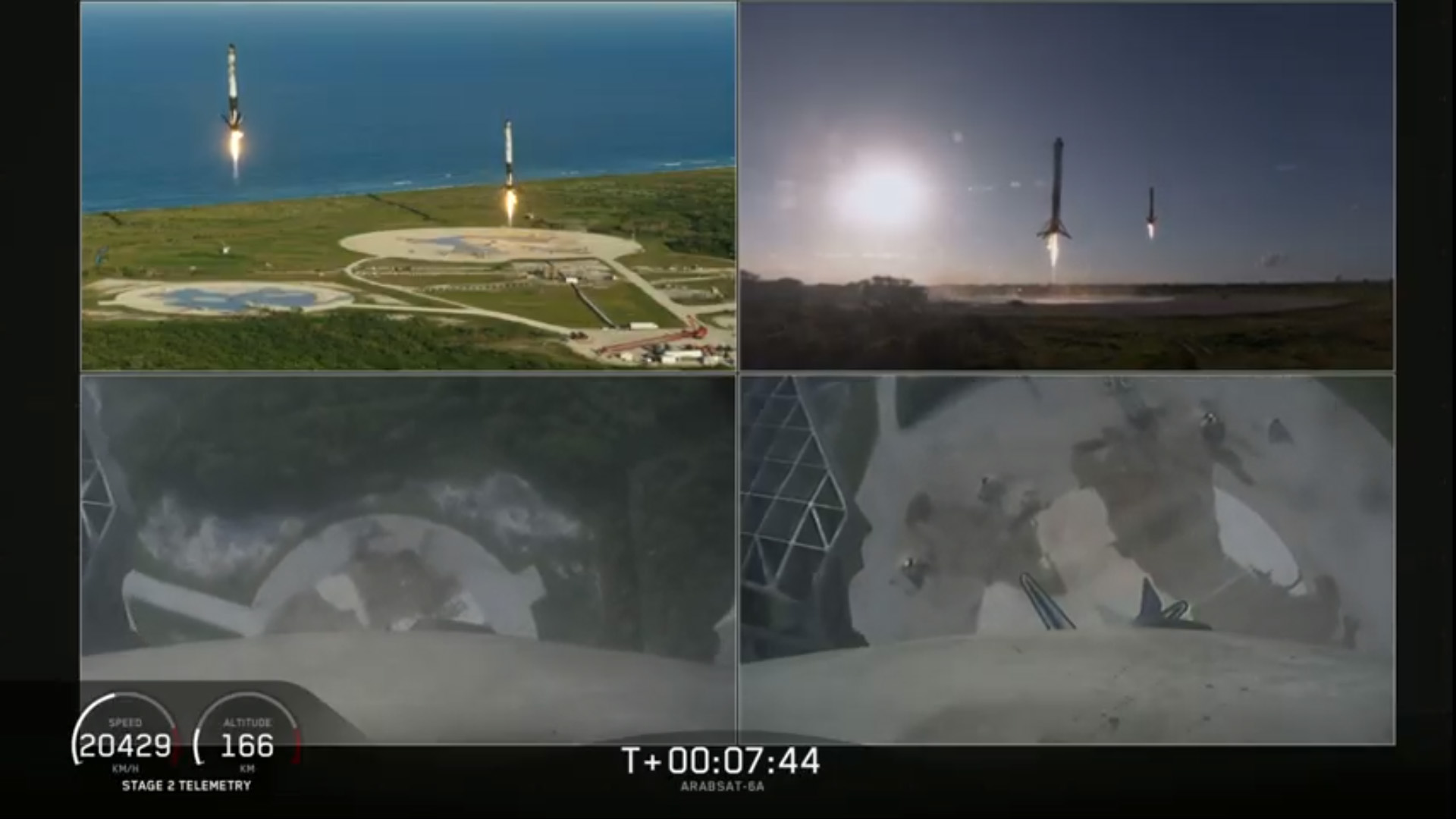
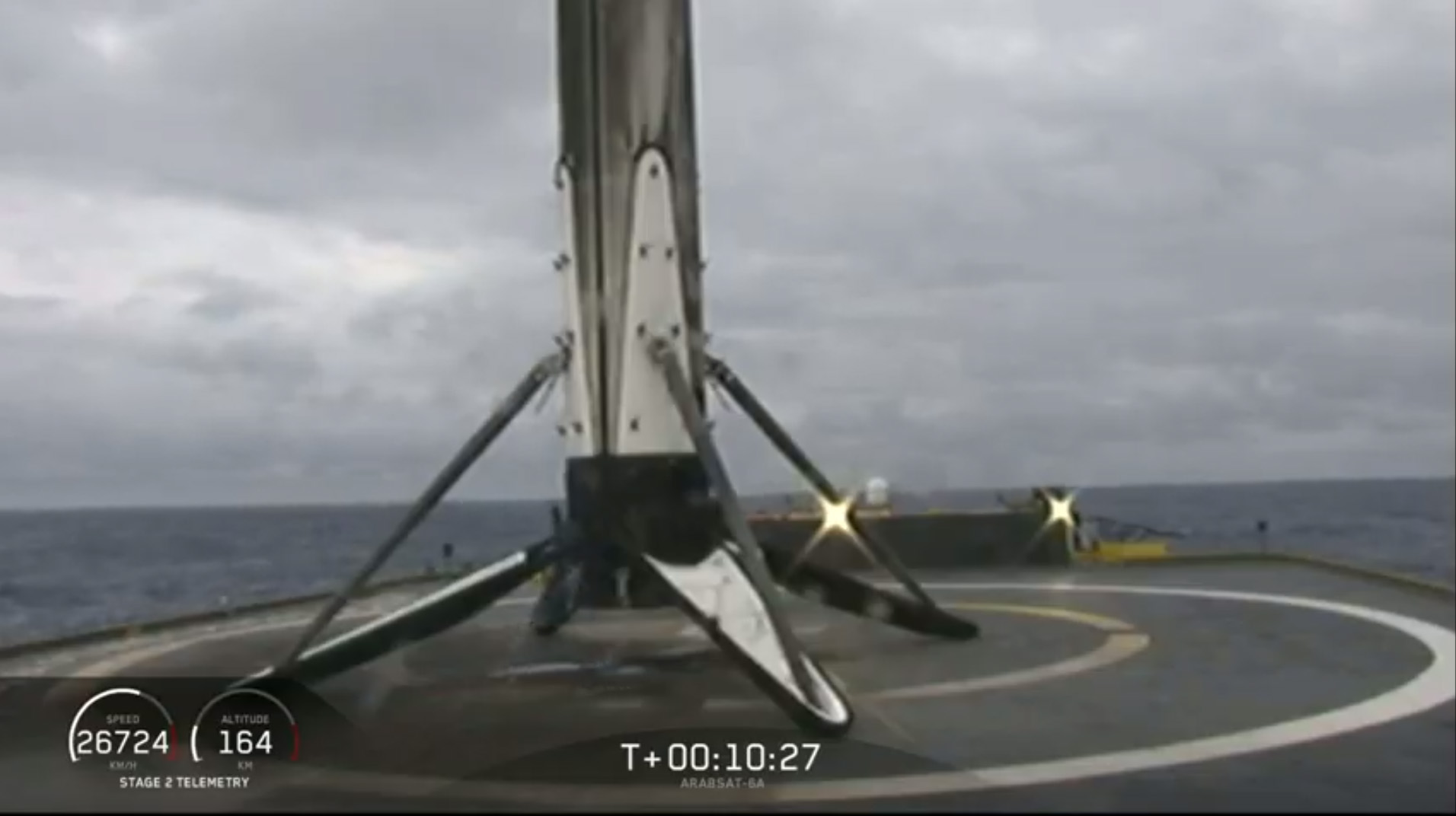
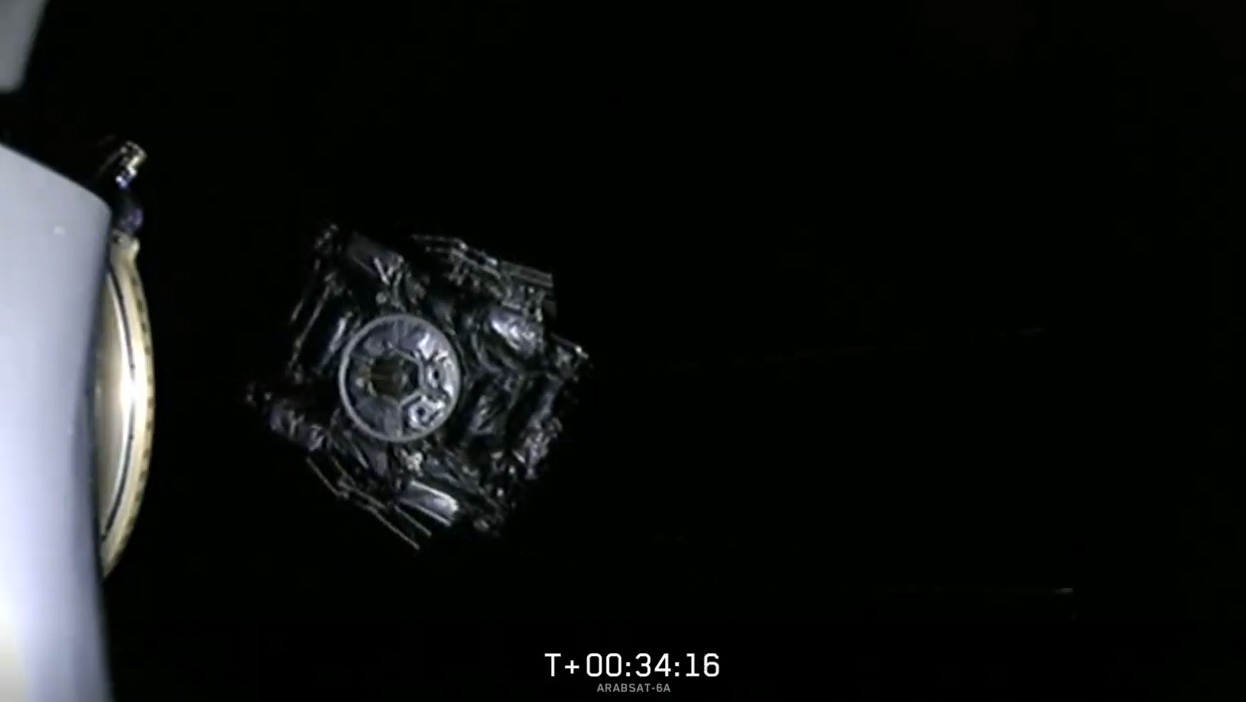
Today's flight was the first of a Falcon Heavy launch featuring souped-up Block 5 versions of its component rockets. (A Falcon Heavy rocket is built of three Falcon 9 first stages, which are combined to form the 27-engine megarocket.) As the rocket's first-stage engines roared to life, they fired in unison and spewed smoke and fire around the launch pad.
SpaceX made the transition to Block 5 for its Falcon 9 flights in May, after the demo flight of Falcon Heavy in February 2018. Today's Falcon Heavy boasted more than 5 million lbs. of thrust, a 10% increase over its predecessor.
In addition to the added thrust, the Block 5 Falcon 9 now features a plethora of upgrades, all of which are designed to facilitate reusability. Previous versions of the Falcon 9 were meant to fly only two to three times; however, Musk says the Block 5 is capable of flying as many as 10 times with virtually no refurbishment between flights.
Get the Space.com Newsletter
Breaking space news, the latest updates on rocket launches, skywatching events and more!
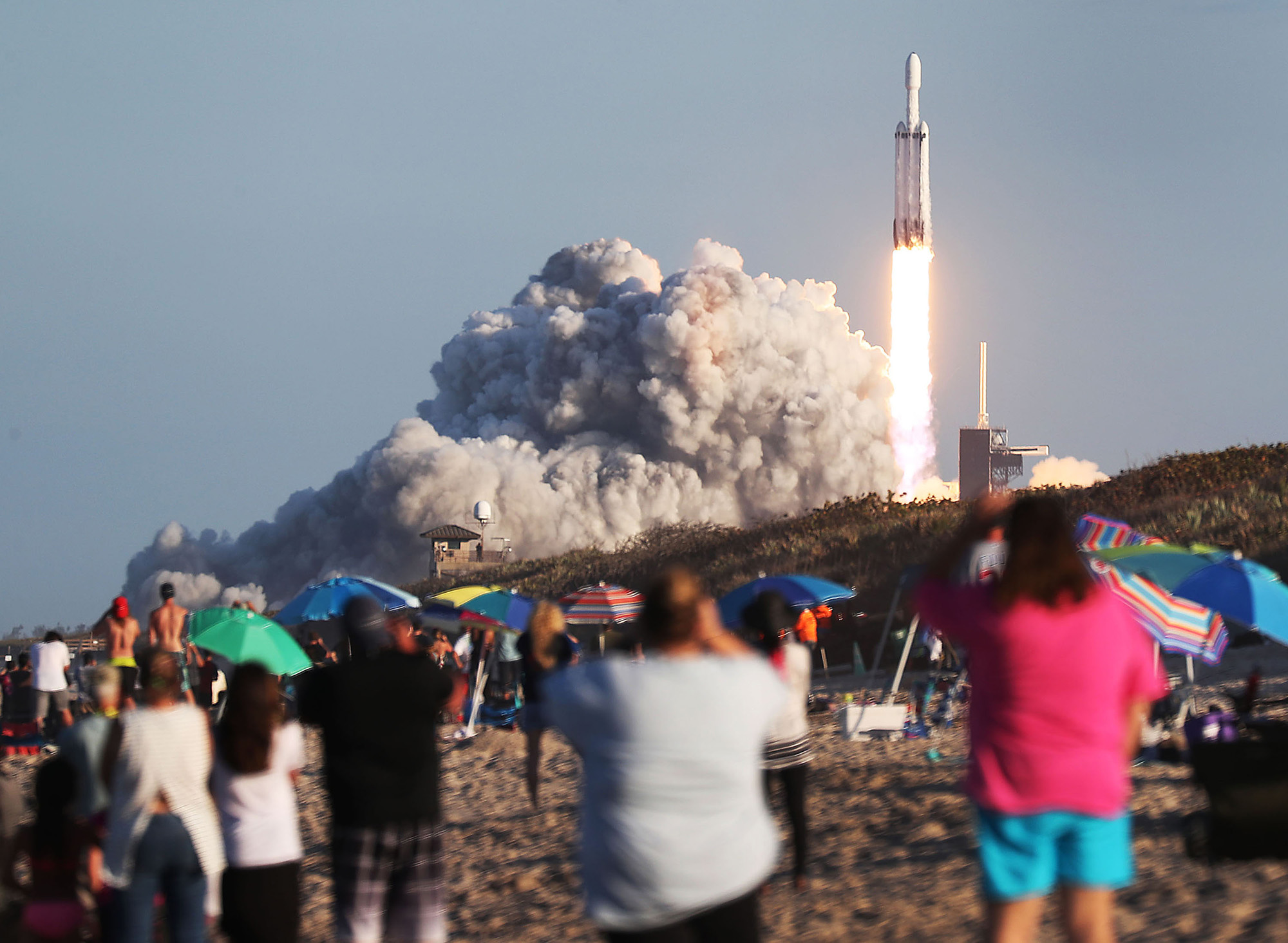
To achieve that goal, engineers developed a suite of upgrades for the company's flagship rocket. The design changes — including improved engines, a more durable interstage (the piece that connects the rocket's two stages), titanium grid fins and a new thermal protection system — were developed to help the rocket better handle the stresses of launch. These technological advances have enabled the company to establish a growing fleet of flight-proven rockets.
Falcon Heavy now has two spaceflights under its belt. Its first mission launched on Feb. 6, 2018, ferrying Elon Musk's cherry-red Tesla Roadster — with a spacesuit-wearing test dummy named Starman sitting in the driver's seat — into orbit. The nearly flawless first launch, which included successful landings by two of the Falcon Heavy's three first-stage boosters, earned SpaceX major accolades.
Related: Out-of-This-World Photos from Falcon Heavy's Historic Debut Flight
The enthusiasm carried over into today's flight, as thousands of onlookers gathered in the area to watch the Falcon Heavy fly.
Sonic booms echoed through the sky as the rocket's two side boosters touched down in unison at SpaceX's nearby landing sites. The third landed on SpaceX's drone ship landing pad "Of Course I Still Love You," stationed in the Atlantic Ocean. (That represents an improvement over the rocket's first flight, when the core stage missed the drone ship and splashed down in the Atlantic Ocean after two of three engines did not fire during the descent.)
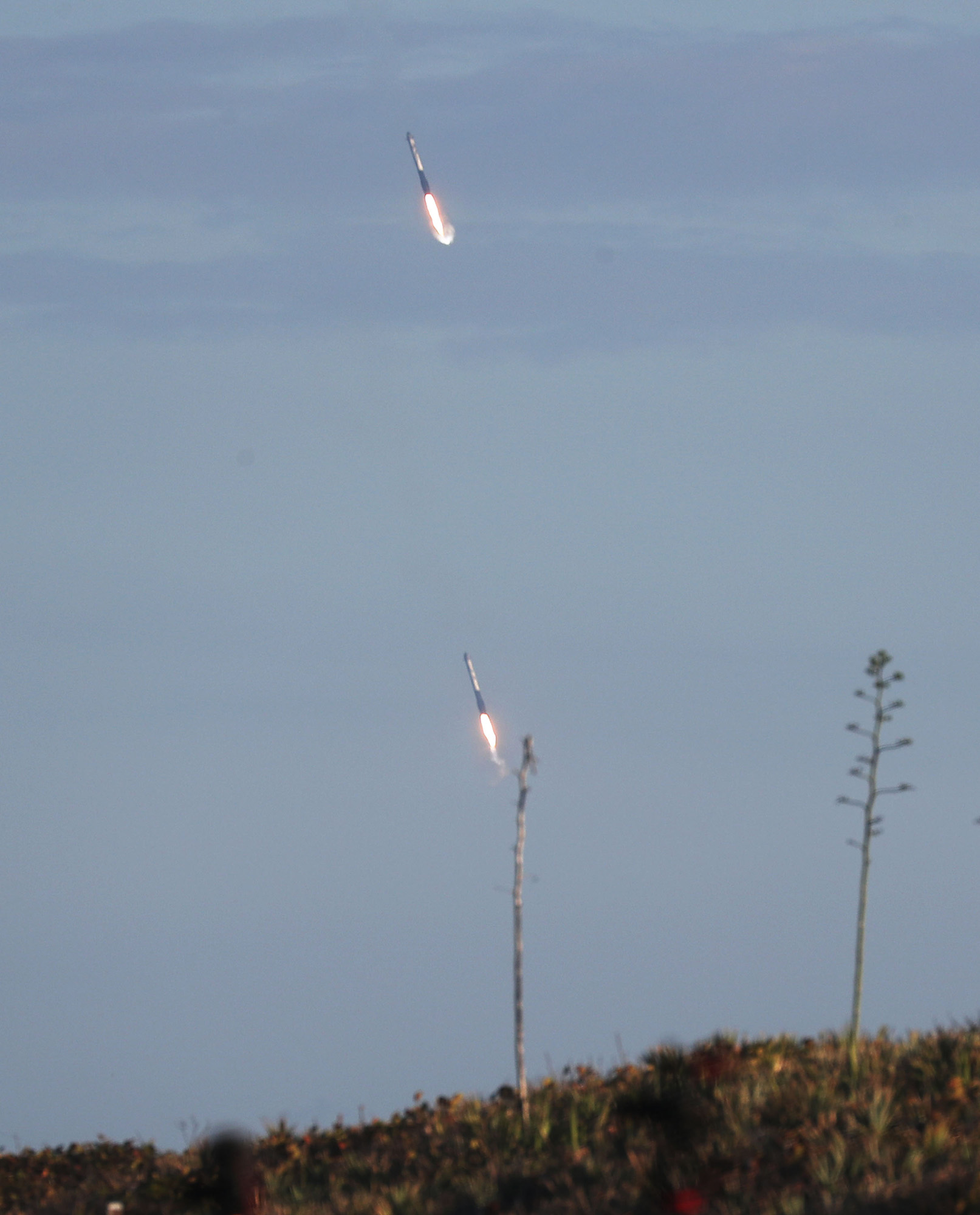
With its first operational Heavy flight in the books, SpaceX is ready to forge ahead with a steady schedule of launches. The next Falcon Heavy flight, due to launch this year, will carry the Space Test Program 2 mission for the U.S. Air Force and a solar-sail mission for The Planetary Society.
Falcon Heavy fetches a base price of $90 million per launch. Last June, SpaceX snagged a highly coveted military mission for the rocket — a $130 million deal to launch an Air Force Space Command satellite sometime in 2020.
SpaceX first announced plans for the Falcon Heavy in April 2011, predicting that its first flight could occur two years later. But that deadline came and went, and it was ultimately seven years before Falcon Heavy got off the ground. Before last year's launch, Musk estimated that SpaceX invested about $500 million to develop the rocket.
The Falcon Heavy is part of a growing list of SpaceX launch services and ongoing projects, which could include launching astronauts to the space station later this year during Crew Dragon's first crewed test flight. But Falcon Heavy won't be the most powerful rocket in SpaceX's arsenal for long. SpaceX is in the early stages of developing a launch system even larger than the Falcon Heavy.
Just days before today's launch, on April 5, the company hit the end of its tether on Starhopper, a test prototype for that massive rocket. That's an initial stage of the company's Starship program to design a fully reusable deep-space launcher for missions to the moon, Mars and beyond. The program already has its first passenger: SpaceX announced last September that Japanese entrepreneur Yusaku Maezawa has booked a trip around the moon that's slated to fly no earlier than 2023.
SpaceX's next launch from the Cape is currently scheduled for April 26, when a Falcon 9 rocket will ferry a Dragon cargo capsule to the International Space Station.
- Elon Musk Was Emotionally Wrecked by SpaceX's 1st Crew Dragon Launch Success — But In A Good Way
- SpaceX's Starhopper Prototype for Starship Reaches End of Its Rope In Test Hop
- See SpaceX Assemble Its Falcon Heavy Rocket for Arabsat-6A Satellite Launch (Time-Lapse Video)
Follow Amy Thompson on Twitter @astrogingersnap. Follow us on Twitter @Spacedotcom and on Facebook.
Join our Space Forums to keep talking space on the latest missions, night sky and more! And if you have a news tip, correction or comment, let us know at: community@space.com.

Amy Thompson is a Florida-based space and science journalist, who joined Space.com as a contributing writer in 2015. She's passionate about all things space and is a huge science and science-fiction geek. Star Wars is her favorite fandom, with that sassy little droid, R2D2 being her favorite. She studied science at the University of Florida, earning a degree in microbiology. Her work has also been published in Newsweek, VICE, Smithsonian, and many more. Now she chases rockets, writing about launches, commercial space, space station science, and everything in between.









